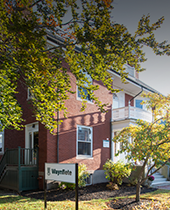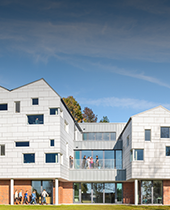5 Hallmarks of Gifted Education for Young Learners
By Anne Hopkins (Lower School director) and Heather Tanguay (2-3 learning specialist)
Like all children, gifted students deserve a curriculum that meets their special needs.
Gifted students thrive in an educational environment that supports them at their intellectual level, regardless of their age. They benefit from faculty who are comfortable teaching in their most advanced subjects and who are not surprised if there are other areas where they may need support. They thrive in schools with a flexible curriculum that expands to follow the gifted child’s interests into deeper study of increasingly complex material. They also benefit from a school environment that provides emotional support and strategies for asynchronous academic and social/emotional development in all grades, from preschool to high school. Most of all, gifted students benefit from being celebrated for their whole selves, for their giftedness and ordinariness alike. At Waynflete, we think all children can benefit from and deserve a “gifted” education.
Below are five key questions to consider—whether you are learning about the gifted-and-talented (“G&T”) program in your school district or looking for an enriched and/ or accelerated program at an independent school.
1. How does the program motivate students?
There are many ways to motivate students of every age—from gold stars to grades. But what are the downsides of reward-based learning? Does it tap into a child’s natural curiosity? Does it build persistence? Will the drive to learn come from within your child? G&T programs that give students of all ages a choice in what they learn are more likely to become self-directed and lifelong learners.
2. How big a role do students play in their own learning?
It may seem counterintuitive, but the most rigorous academic studies are often the result of tapping into students’ interests and talents. Waynflete’s preschool program captures the magic of this approach. It is an emergent curriculum, with 3- and 4-year-olds literally deciding what they will study. “Our students feel great ownership of our classroom, in part because our curriculum is driven by their ideas, questions, and interests,” says preschool teacher Bob Mills. “Their natural engagement in the content allows them to deepen and refine skills such as language, math, science, music, geography, and art—without losing their excitement for learning.”
It’s about more than just fun. Teacher and artist Gretchen Schaefer stresses that teachers look for topics that 1) captivate students, and 2) have the potential for depth and multiple extensions. “We help students choose topics of study that we think have the potential for sustained interest.” One of the longest-running studies “in history” began with some questions about ferryboats.
Early questions about ferries soon grew into a textbook example of an emergent curriculum. After learning about local ferries and ferryboat captains, the students branched out to anchors, islands, lighthouses, and waves. Never underestimate young learners’ capacity for learning. Every day on his way to school, one little boy checked the flags at the Coast Guard station to find out the weather conditions in Casco Bay. Soon every student knew the meaning of the flags that were raised in the classroom: one red triangle for small craft warnings, two for gale warnings; one red square for a storm warning and two for a hurricane.
3. How far does the program allow students to follow their interests?
A G&T program should encourage students to go deep in response to emerging interests, making learning more meaningful and empowering students to play a direct role in their education. It also contributes to classrooms humming with happy and engaged students.
At Waynflete, we believe that students’ questions are the best starting place for deep learning. For example, just when it seemed the unit described above was coming to a close, a student noticed a lobster boat in one of the books about ferries, and the class was off on yet another related subject. The refrigerator box they had turned into a ferry became a lobster boat named The Decapod (after a crustacean they had studied that has five sets of walking legs). Of course, that led to a lobster shack, complete with café tables and menus. “We had kids designing menus like crazy,” says teacher Debbie Rowe. “We had students who learned how to write ten words because they really wanted to make a menu.”
4. What is the teacher’s role in learning?
Teachers have a critical role to play in developing a curriculum that fosters student-directed learning. In early education, they model how to ask and explore a good question. Morning meetings may include a “provocation”—an open-ended question that is intended to provoke numerous and differing responses. The introduction of such questions gives students a chance to learn how to respond to and learn from each other. (The results can be startling. In a discussion of the great white shark, one student declared that sharks are “predators.” After a few minutes of guessing what a predator was, another child asked, “Are we predators?”)
There is a wealth of content, concepts, and skills that elementary school students must master before entering middle school. Ideally, though, teachers can still structure reading assignments, research, projects, and discussions that provide space and encouragement for student questions, interests, and choices. A quick look at the arrangement of the classroom can reveal a lot about the role of students and teachers. Small and large tables where children can easily group and regroup themselves suggest a more collaborative, discussion-based approach to learning.
5. How much does the curriculum allow for differentiated learning?
Is your child charging ahead in one area but lagging a bit in others? Many G&T programs are designed to differentiate learning for students who have demonstrated abilities in one or more subjects. Most programs focus on students who are “ahead” in either reading or math skills. Differentiated assignments can also be designed to match the skill levels of different students but still extend the thinking of every child.
What should you look for? Study the student work on the classroom walls. On math worksheets, see if students are asked to arrive at a single “right answer.” Also search for examples of enriched curriculum, which is often sparked by open-ended questions that allow students to approach math at different levels—and learn that there are different ways to solve a problem. For example, students entering Waynflete’s Kindergarten-First Grade classroom will be greeted with a problem like this on the board:
“I notice. I wonder”
9, 16, 25, 43
Such open-ended questions are accessible to all the students in the room, and provide opportunities for others to engage in playful exploration and discussion that extends their thinking and enjoyment of math. “There’s no right answer and no fear of giving the wrong answer,” says K-1 teacher Jess Keenan. “Open-ended questions feed their curiosity, which is easily lost as they get older.”
Young learners who need to master basic material benefit from working at their own speed and level. Try to discern whether a G&T program provides many ways for different kinds of learners to approach and understand literacy and numeracy. For example, see if the program provides different ways for younger students to understand math (through pictures, numbers, manipulatives, and models).
At Waynflete, this model of G&T learning is built into our preschool and elementary school programs. We believe students learn most deeply through work that is accessible to all; encourages curiosity, exploration, and flights of fancy; and extends over time.



